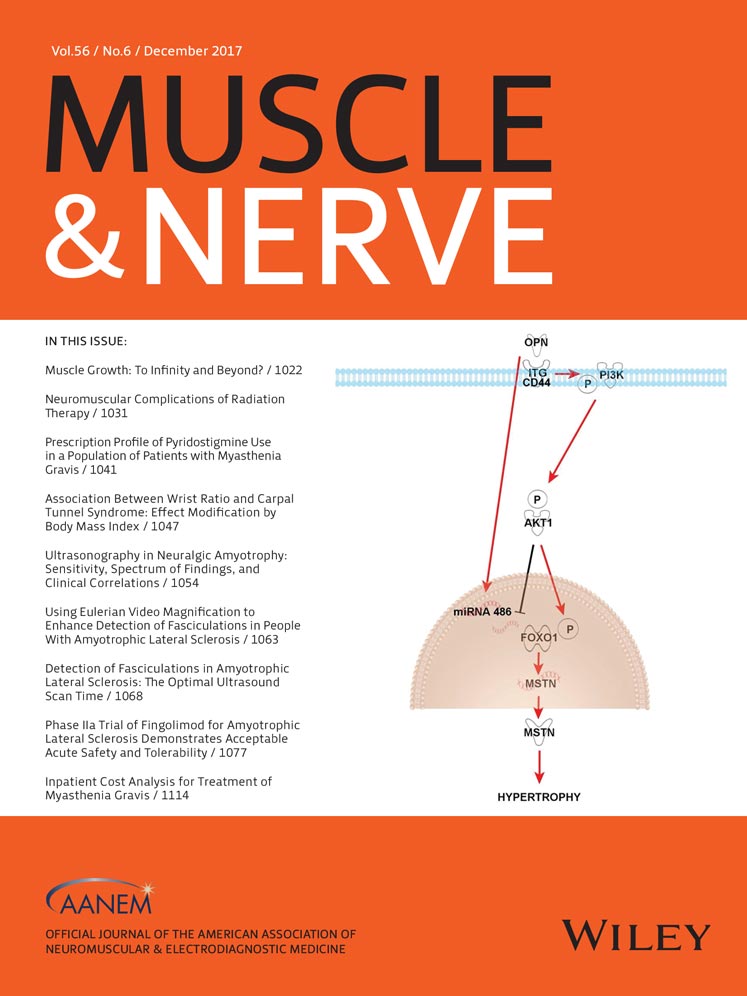Selected Highlights in the December, 2017
The authors of this study found that a square wrist was associated with both carpal tunnel syndrome (CTS) and with abnormal but asymptomatic nerve conduction studies, and that body mass index was a strong modifier of the relationships, such that the associations were not seen among obese individuals. In an accompanying editorial, Drs. Franklin and Gray place these findings in the broad context of the CTS literature, concluding that the relationship between some work activities and CTS has become clear, but that there is far less clarity in the relationship between wrist dimensions and work-related CTS.
This interesting study found that abnormal ultrasonographic findings such as nerve and fascicle constriction and rotational phenomena were more likely to be found in individual nerves, rather than in the brachial plexus itself, and that some such findings were related to clinical outcome, suggesting that ultrasound may be useful in making decisions about surgical intervention. An accompanying editorial by ultrasound expert Dr. Nens van Alfen emphasizes the apparent importance of fascicular entwinement and nerve torsion as demonstrated in the article's accompanying video, and comments on the broader topic of the integration of clinical, electrodiagnostic, and ultrasound information in the diagnostic and therapeutic processes.
Although fasciculations are neither unique to, nor diagnostic of, amyotrophic lateral sclerosis (ALS), they can support the diagnosis in the proper clinical context. The authors of this study used a technique known as Eulerian video magnification (EVM) to better visualize fasciculations, and the videos that accompany the article are striking. In comparison with simple clinical observation, EVM usually revealed more fasciculations in patients with ALS. When control subjects were studied, fasciculations usually were not found. EVM may be a useful tool in the diagnostic armamentarium for ALS.
Ultrasound is more sensitive for detecting fasciculations in some clinical syndromes than observation or needle electromyography. Of course, physicians do not have unlimited time to search for fasciculations, leading to the question of how long an ultrasound scan of a muscle should be performed to permit the examiner to be reasonably certain of detecting fasciculations if they are present. Based on this study, the answer would appear to 60 seconds. Specifically, the authors found that with that scan time, the probability of detecting 2 fasciculations in all of the muscles they studied was greater than 0.9.
The search for effective treatments for amyotrophic lateral sclerosis (ALS) has been long and, usually, frustrating. The etiology and pathogenesis appear to be multifactorial, and to include inflammation. Fingolimod is an immunomodulating agent that is used to treat multiple sclerosis. It reduces circulating lymphocytes and has improved survival in SOD1 ALS mice. In this study, it was found to be safe and well-tolerated in short-term use, and to be capable of reducing circulating lymphocytes in ALS patients. Although there were no observable effects on scores of physical or respiratory function, the study was underpowered to detect such changes. Larger and longer studies will be needed to assess efficacy.
Inpatient Cost Analysis for Treatment of Myasthenia Gravis (Page 1114)
Accurate data on the cost of caring for patients with neuromuscular diseases provides useful information when formulating health care policy. Using a large US database of hospital discharge information, this study found that the cost of caring for inpatients with myasthenia gravis rose an astounding 13-fold from 2003 to 2013 due to a doubling of cost per discharge and a greater than 6-fold increase in discharges with this diagnosis. The authors ultimately conclude that changes in physician decision-making regarding admission played the largest role. They note, for example, the need to admit patients for intravenous immunoglobulin (IVIG) because of lack of Medicare and Medicaid payment for outpatient administration.




